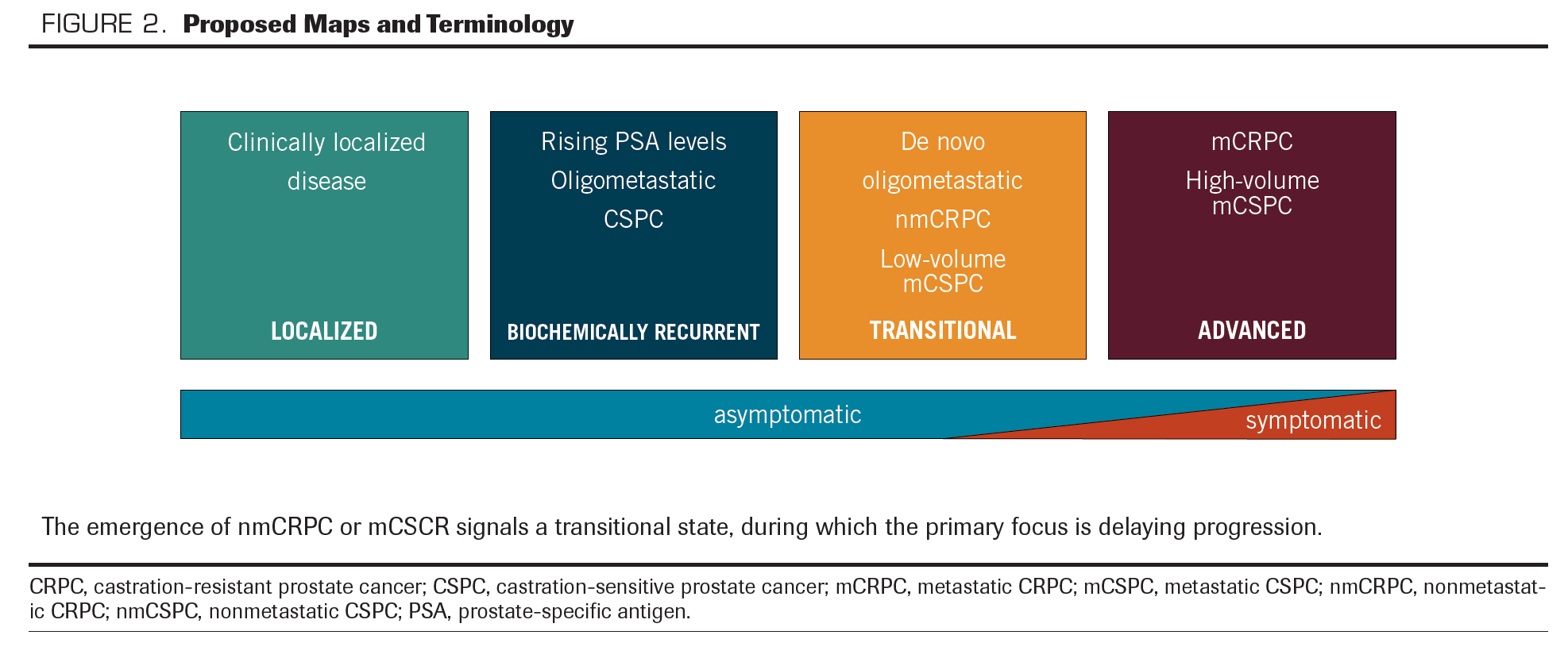Focus on Transitional Disease: A Critical Interval to Delay Progression of Prostate Cancer
ONCOLOGY® editorial board member E. David Crawford, MD, and colleagues, propose a new model for guiding the treatment of prostate cancer that focuses on a “transitional state,” which occurs during the interval of progression to metastatic castration-resistant prostate cancer.
Models of prostate cancer (PCa) progression guide the clinician in decisions about patient care. The prevailing categorization of PCa, however, does not take into account next-generation imaging (NGI), molecular and biologic markers of disease progression, or the impact of genetic alterations, either prognostically or in response to therapy. In addition, the current model of clinical states characterizes PCa as a stepwise continuum, obscuring the important interval when transitions occur from one clinical state to another. The transitions from nonmetastatic castration-resistant PCa (nmCRPC) or metastatic castration-sensitive PCa (mCSPC) to metastatic castration-resistant PCa (mCRPC) are seminal events in disease progression and are associated with significantly decreased survival if left unrecognized and untreated.
The RADAR (Radiographic Assessments for Detection of Advanced Recurrence) Group originally convened in 2013 to complement current PCa guidelines with practical decision-making. In 2020, RADAR IV convened to evaluate the use of NGI for assessing patients with mCSPC and nmCRPC and to review results from studies evaluating newer agents, primarily next-generation androgen receptor antagonists (antiandrogens), for delaying progression to mCRPC. Recommendations were also made regarding PCa nomenclature to accurately represent transitional disease and guide treatment decisions.1
This article is a follow-up to RADAR IV and represents a call to action for earlier intervention in the disease state. We need to implement clinical trials that evaluate early and therapeutic layering of agents to delay progression to mCRPC. Clinicians are encouraged to consider shifting their strategy from waiting for men to develop mCRPC to actively preventing its onset. NGI, biomarkers, and antiandrogens are tools to allow earlier initiation of therapy and prolong survival.
Overwhelming evidence has shown that metastasis and castration resistance (and shorter times to reach them) drastically lower overall survival (OS). Recognizing the transition state—the period before these events—is crucial to extending survival and improving quality of life. Thus nmCRPC, mCSPC, and oligometastatic disease are not just steps along a continuum, but critical points for intervention and clinical studies to delay mCRPC (Figure 1). We propose to further distinguish oligometastatic mCSPC from high-volume mCSPC, with the former being a transitional state and the latter being an advanced state. This proposal also recognizes the dramatically inferior outcomes for men presenting with de novo mCSPC, which is thus classified as an advanced state downstream of the transitional state.
FIGURE 1. Prevailing Maps of Prostate Cancer

Next-Generation Imaging
Distinguishing between hormone-sensitive biochemical recurrence and mCSPC depends in part on current imaging modalities (CT and bone scans), which are limited in their ability to accurately detect low-volume PCa dissemination to lymph nodes and bone. More-sensitive molecular and functional imaging technologies are emerging, such as 18F-fluciclovine PET, PET imaging based on prostate-specific membrane antigen (PSMA), and multiparametric MRI. Earlier intervention via evaluation with these NGI modalities will reduce the time to discovering metastatic disease and will provide a potential increase in OS. RADAR IV suggests that a single PET imaging (either fluciclovine or PSMA) may be sufficient to determine treatment options in most cases.
Regarding oligometastasis, both fluciclovine and PSMA PET offer the potential to detect disease both within and outside the prostate bed early in its development (eg, within the anastomosis or the pelvic lymph nodes). Disease in these disparate locations has differing treatment implications.
The advancement of imaging technology is intertwined with the advancement of biomarkers and pharmaceuticals. Well-designed clinical trials that lead to the approval and use of NGI are necessary in part because studies of newer treatments depend on the acceptance and availability of NGI.
Biomarkers
Molecular and genomic biomarkers may indicate disease that is aggressive or at high risk for metastasis. PTEN deficiency, TP53 mutation or loss, and aberrations in PI3K signaling are just a few of the markers emerging as promising predictors from large studies. Results of a recent larger registration trial in patients with nmCRPC, SPARTAN (NCT01946204), suggest that patients with higher DECIPHER scores have greater treatment effects with apalutamide plus androgen deprivation therapy (ADT) than those with low scores.2 Biomarkers related to immunologic interventions have also received attention in mCRPC, and epigenetic markers, such as genetic hypermethylation patterns, can convey information about prognosis.
Preventing Progression
In 3 recent large registrational trials, the addition of third-generation antiandrogens—eg, apalutamide (Erleada), enzalutamide (Xtandi), and darolutamide (Nubeqa)—to ADT in men with nmCRPC, based on conventional imaging and PSADT of 10 months or less, significantly prolonged metastasis-free survival. In other words, this strategy delayed progression to mCRPC, and it subsequently demonstrated a statistically significant benefit in median OS compared with placebo plus ADT (73.9 vs 59.9 months with apalutamide; 67.0 vs 56.3 months with enzalutamide; medians for OS not reached with darolutamide).1 Based on these findings and a tolerable adverse effect (AE) profile compared with ADT alone, all 3 agents are now approved by the FDA to treat patients with nmCRPC.
Similarly, in 2 recent large phase 3 registrational trials, the addition of apalutamide (TITAN; NCT02489318)3 or enzalutamide (ARCHES; NCT02489318)4 to ADT in men diagnosed with mCSPC by conventional imaging showed a statistically significant improvement in progression-free survival (PFS)—in other words, delayed progression to mCRPC—and in the case of apalutamide, also showed a statistically significant improvement in median OS. Both of these agents are now also approved to treat men with mCSPC.
Strong evidence from these large trials as well as observational studies confirm that the earlier results of improved PFS with modern therapeutic agents have indeed translated into longer OS, with tolerable AEs and quality of life comparable with that of ADT alone. Although patients may be on therapy longer, which risks AEs and higher costs, these potential drawbacks are more than balanced by improved OS. Good outcomes represent a good value proposition despite the potential for increased expense.
Conclusions
We now have new tools and novel therapeutic regimens that effectively identify appropriate patients, delay progression to mCRPC, and afford OS benefits. These advances prompt reconsideration of how we categorize and describe PCa. It is imperative that accurate imaging be used to identify the proper matches between situation and therapy.
A model to describe the continuum of PCa should fill 4 needs.5 It should (1) describe the progression of PCa from diagnosis to death; (2) represent both the natural and treated history of the disease and allow iterative reassessment of prognosis over time; (3) have clearly defined, mutually exclusive disease states; and (4) support clinical decision-making based on the risk of disease progression. An additional issue is how the increased understanding of disease progression that is emerging from NGI should be incorporated—in other words, how to go forward with an “imaging state.”
We suggest dividing PCa into 4 stages: localized disease, biochemically recurrent disease, transitional disease, and advanced disease (Figure 2). Definition of a transitional disease state is meaningful not only because of differences in biology and prognosis vs advanced PCa, but also because newer therapies can significantly prolong transitional disease and delay progression to advanced disease. Also, defining this state provides a framework for considering future clinical trial design using common nomenclature.
FIGURE 2. Proposed Maps and Terminology

Delaying progression is an important and achievable goal for patients with transitional PCa, and NGI can permit earlier identification of these patients and refine risk stratification. It is important to achieve consensus on more easily understood terminology to communicate with health care professionals, as well as to clearly and effectively talk to patients. A map of disease states should make clear the need to initiate appropriate treatment—particularly for transitional disease. Earlier identification of specific disease states and interventions will translate to improved outcomes.
FINANCIAL DISCLOSURES: EDC is a speaker for Janssen, Bayer and Pfizer. CJK declares that he declares stock ownership in Stratify Genomics. RGH and AHB report no conflicts of interest that might be relevant to the contents of this manuscript. DPP reports consultant fees from Advanced Accelerator Applications, Amgen, Astellas, AstraZeneca, Bayer, Bicycle Therapeutics, Boehringer Ingelheim, Bristol Myers Squibb, Clovis Oncology, Eli Lilly, Exelixis, Incyte, Janssen, Mirati, Monopteros, Pfizer, Pharmacyclics, Roche, Seattle Genetics, Urogen and grant support from Advanced Accelerator Applications), Agensys Inc, *Astellas, AstraZeneca, *Bayer, BioXcel Therapeutics, Bristol Myers Squibb, Clovis Oncology, Eisai, *Eli Lilly, *Endocyte, Genentech, *Innocrin, MedImmune, Medivation, Merck, Mirati, *Novartis, Pfizer, *Progenics, Replimune, Roche, *Sanofi Aventis, Seattle Genetics
*Denotes study trials that have terminated
Crawford is chairman, Prostate Conditions Education Council; editor in chief, Grand Rounds in Urology; and professor of urology, University of California San Diego, La Jolla, California.
Kane is a urologist and dean of dean of Clinical Affairs at University of California San Diego School of Medicine in La Jolla, California.
Harris is CEO and president or UroPartners, LLC, in Chicago, Illinois.
Bryce is medical director of the Genomic Oncology Clinic at Mayo Clinic in Scottsdale, Arizona.
Petrylak is a professor of medicine and urology at Yale School of Medicine and co-leader of Cancer Signaling Networks at Yale Cancer Center in New Haven, Connecticut.
References
1. Crawford ED, Andriole G, Freedland SJ, et al. Evolving understanding and categorization of prostate cancer: preventing progression to metastatic castration-resistant prostate cancer: RADAR IV. Can J Urol. 2020;27(5):10352-10362.
2. Feng FY, Thomas S, Gormley M, et al. Identifying molecular determinants of response to apalutamide (APA) in patients (pts) with nonmetastatic castration-resistant prostate cancer (nmCRPC) in the SPARTAN trial. J Clin Oncol 2019;37(7 Suppl):abstr 42. doi:10.1200/JCO.2019.37.7_suppl.42
3. Chi KN, Agarwal N, Bjartell A, et al; TITAN Investigators. Apalutamide for metastatic, castration-sensitive prostate cancer. N Engl J Med. 2019;381(1):13-24. doi:10.1056/NEJMoa1903307
4. Armstrong AJ, Szmulewitz RZ, Petrylak DP, et al. ARCHES: efficacy of androgen deprivation therapy (ADT) with enzalutamide (ENZA) or placebo (PBO) in metastatic hormone-sensitive prostate cancer (mHSPC). J Clin Oncol. 2019;37(15 Suppl):abstr 5048. doi:10.1200/JCO.2019.37.15_suppl.5048
5. Scher HI, Heller G. Clinical states in prostate cancer: toward a dynamic model of disease progression. Urology. 2000;55(3):323-327. doi:10.1016/s0090-4295(99)00471-9

Prolaris in Practice: Guiding ADT Benefits, Clinical Application, and Expert Insights From ACRO 2025
April 15th 2025Steven E. Finkelstein, MD, DABR, FACRO discuses how Prolaris distinguishes itself from other genomic biomarker platforms by providing uniquely actionable clinical information that quantifies the absolute benefit of androgen deprivation therapy when added to radiation therapy, offering clinicians a more precise tool for personalizing prostate cancer treatment strategies.